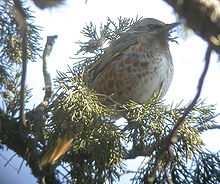Naumann's Thrush
| Naumann's Thrush | |
|---|---|
 | |
| Conservation status | |
| Scientific classification | |
| Kingdom: | Animalia |
| Phylum: | Chordata |
| Class: | Aves |
| Order: | Passeriformes |
| Family: | Turdidae |
| Genus: | Turdus |
| Species: | T. naumanni |
| Binomial name | |
| Turdus naumanni Temminck, 1820 | |
Naumann's Thrush (Turdus naumanni) is a member of the thrush family Turdidae which breeds eastwards from central Siberia. It is closely related to the more northerly breeding Dusky Thrush T. eunomus; the two have often been regarded as conspecific.
This species breeds in open woodland areas; Dusky Thrush, as would be expected, is more tolerant of mountainous and tundra-edge habitats. This species is strongly migratory, wintering south to southeast Asia, principally in China and neighbouring countries. It is a rare vagrant to western Europe.
It nests in trees, laying 3-5 eggs in an untidy but neatly lined nest. Migrating birds and wintering birds often form small flocks. It is omnivorous, eating a wide range of insects, especially mosquitoes, earthworms and berries.
This is a medium-sized but stocky thrush, reminiscent in structure of a small Fieldfare. The underwing is reddish brown, and there is a pale supercilium.
Naumann's Thrush has pale brown back and head. The face, breast, flank spots and rump are reddish, and the belly and undertail are white, whereas Dusky Thrush has a darker brown back and rump, and the face, breast, and flank spots rump are black. The belly and undertail are white.
The female is fairly similar to the male, but immatures have a weaker patterning.
The song of Naumann's Thrush may differ from the simple fluted or whistling Redwing-like song of Dusky Thrush.
The scientific and English names of this bird commemorate the German naturalist Johann Andreas Naumann.
References
- ↑ BirdLife International (2012). "Turdus naumanni". IUCN Red List of Threatened Species. Version 2013.2. International Union for Conservation of Nature. Retrieved 26 November 2013.
Bibliography
- Thrushes, Clement and Hathway, ISBN 0-7136-3940-7
Public domain image from a 1905 field guide
